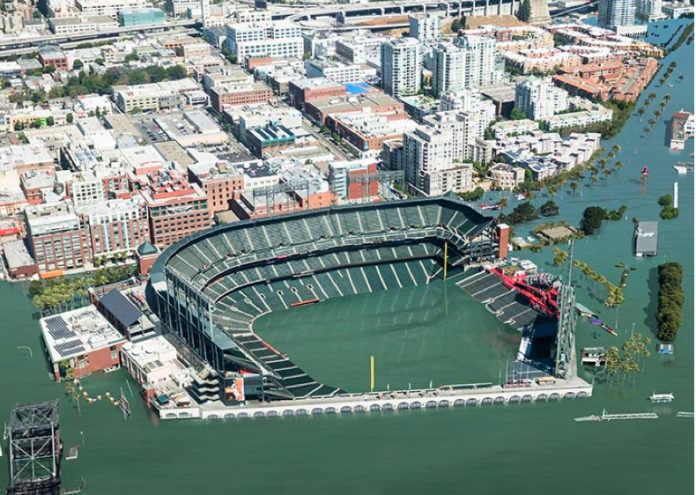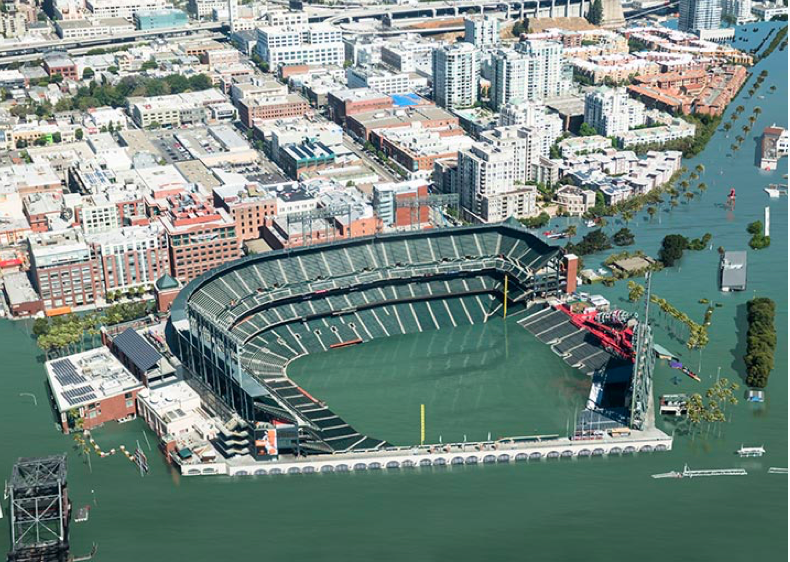
“In California, facts and science still matter,” said Gov. Jerry Brown in a prepared statement. “These findings are profoundly serious and will continue to guide us as we confront the apocalyptic threat of irreversible climate change.” (on the release of California’s Fourth Climate Change Assessment, SF Comical, August 28, 2018)
While Gov. Brown loves to bash Trump’s climate change denial as “irrational,” while smugly claiming that “facts and science still matter” in his state, the actual facts on applied climate change denial reveal the exact opposite. Brown and his Sacramento corporate Democrat allies, assisted by the likes of the Chronicle and SPUR, are adopting a pro-corporate agenda that, in fact, denies climate change impacts in an increasingly irrational manner.

While talking climate change, they act as if it simply did not exist. And they get away with it. Time and again.
In August, this dangerous game was revealed most starkly in the release of two contrasting documents: California’s Fourth Climate Change Assessment not only lays out the challenges facing us at the statewide level, but also, through the addition of nine separate regional studies, shows what practical impact climate change will have at the regional level, using new and focused data available for the first time. The second is SPUR’s “Four Future Scenarios for the San Francisco Bay Area”which plants a big, wet, kiss on the lips to endless commercial and residential development, which it calls “A New Social Contract.”
The Fourth Climate Change Assessment
In 2006, Gov. Schwarzenegger ordered a periodic statewide assessment of climate change impacts on California. The fourth such assessment includes—for the first time— a comprehensive look at impacts at the local level in addition to the statewide analysis, because, as the report states “the vast majority of adoption, planning, and implementation will happen at local to regional levels.” Perhaps another unstated reason for the inclusion of new local data is that climate scientists realize that the real push back against the national move by the Trump government to remove climate change policies and regulations can best come from localities that will feel the brunt of the shift away from climate change control policies and programs. The old Green Party saying “think globally, act locally” is still essential politics.
The assessment projections of climate change impacts are the most detailed and up-to-date available; they include 44 technical reports, nine regional reports, three topical reports and a Statewide Summary. It lays out the known facts and current science of how rising temperatures affect weather patterns and sea temperatures, which cause sea levels and tides to rise, change rainfall frequency and patterns, and in a California context results in both droughts and periodic “atmospheric rivers.”
In a separate report, these statewide climate phenomena are studied in detail at the Bay Area level. The Assessment lays out the specific impacts—some familiar, some new—that we can expect. The expected sea level rise (SLR) is between .74 m (2.43 feet) to 1.37 m (4.5 feet) by 2100— an accelerated pace when compared to the eight inches it rose from 1918 to 2018.
And then the unexpected eye-popper: That it is “plausible with very low probability” that SLR could be “as high as 2.87 m [9.4 feet] at San Francisco” by 2100! (page 31). Also eye-popping was the data from studies showing Bay-filled land sinking faster than its historic rate of 2mm a year to 10mm/yr along the SF waterfront and at SFO, greatly accelerating the effect of SLR locally.
But what is most impressive is the assessment’s linking of events caused by climate change with each other, showing the “real world” challenges these simultaneous events present us with. Two examples from the Bay Area report show these linkages.
Wildfires will increase in frequency and power as drought and temperatures rise. While the primary impact will be in suburban “wildland-urban interface” areas where the fires will occur, huge public health impacts are expected in urban areas, as air quality will be greatly reduced from these larger and longer-duration fires. Efforts to reduce the severity of wildfires by proscribed burns may well add to the problem and needs to be further studied in the Bay Area. (pg. 56)
Bay Area temperatures increased 1.7 degrees each year from 1950 to 2005. The study projects that by 2100 they will increase 4.1 to 6.2 degrees each year (pg. 61). This will prompt a new demand for air conditioning in coastal urban communities (pg. 51). Nearly half of the region’s housing stock was built before 1969 (nearly two-thirds of San Francisco’s housing stock was built before 1969), making retrofitting air-conditioning both expensive and energy inefficient. The rising need for air-conditioning would also place huge new demands on the region’s electrical grid, which is vulnerable to power outages during wildfire events, and which “will face more frequent and severe threats in the coming decades,” as the assessment concludes.
Finally, the assessment places a huge emphasis on the role of neighborhoods and communities in both devising plans and implementation strategies, claiming that the role of community organizations and social networks “is now emerging clearly” and may be “a most important factor.”
SPUR: Four Future Scenarios for the San Francisco Bay Area
While SPUR, like Brown, admits to the existence of climate change, of the four “scenarios” advanced–Gated Utopia, Bunker Bay Area, Rust Belt West and A New Social Contract (guess which one SPUR prefers?)—none of the “assumptions,” “uncertainties” and “outcomes” listed in the document (page 18) include the specific impacts or even any mention of climate change. While a separate section, “External Forces,” specifically features “climate change,” it is focused on only one aspect: sea level rise. Its exceedingly general language, a mere six paragraphs, cover only one of the paper’s 40 pages. It ignores the inter-relatedness of the impacts of climate change, and in so doing understates the problem, concluding its brief discussion with a sentence clear only in its dismissive ambiguity: “How much we prepare for climate change will in large part impact the severity of its effects” (pg.26).
What SPUR’s paper was all about was pushing its view of regulation-free commercial and residential development, while ignoring any real discussion of climate change and its vexing questions and realities. SPUR’s “future scenarios” read like today’s Chronicle: yesterday’s news and last century’s mindless boosterism for unlimited market-rate development.
Three of the scenarios are merely “straw men” cartoons, fictitious inventions of SPUR staff time and again advanced with no reality nor accuracy in their positions. Not one even mentions limitations on development imposed by power grid failures, drying up of potable water supplies, the inundation of roadways, or the impossibility of reversing the irreversible.
For example, in the “Rust Belt West” scenario, seemingly aimed at 48 Hills readers, the Bay Area is brought to its knees because of the “absence of capital.” This highly improbable event was brought about by the Bay Area being the “home of the American left …[which] became increasingly radicalized.”
“Important protections for workers were taken too far: Minimum wage eventually grew to $75 per hour. Local hire laws made it hard to bring in workers from around the world, eventually regulating wages and restricting who could get fired.”
Class bigotry and cartoon characterizations of political opponents, along with ignoring the human and economic impacts of climate change. Sound like anyone else you know?
Understand the essential similarity between SPUR staff and Trump: both are urban development hustlers seeking OPM (Other People’s Money) to further their careers. Neither can admit the truth of their opponent’s positions, nor the reality of climate change, and still expect “capital” to flow in their direction.
But it is not just SPUR, of course, that acknowledges the “reality” of climate change and then acts if that reality does not exist and hopes no one calls them on it.
Wildfires Without Cost and Getting the Jobs-Housing-Transit Connection Wrong
In a last-minute vote in the closing hours of the legislative session, a majority of Sacramento Democrats gave Gov. Brown the legislation he asked for: SB901, which gives the state’s private utilities both access to state financing and the ability to pass to its customers the cost of lawsuits filed by people whose homes and businesses were destroyed by wildfires caused by the utilities’ equipment. CALFIRE has found evidence that in 11 of the 16 wildfires from last October, PG&E broke safety laws in the use of its equipment, including the use of automatic switches that re-powered downed lines in high fire hazard areas.
Climate change in California, as the assessment clearly demonstrates, means more and bigger wildfires. Knowing this and removing economic incentives to lessen the chance of wildfires from a principal human source of ignition—unsafely operated utility monopolies—is simply irrational — indeed, deadly irrational. Our entire state contingent, Assembly members Phil Ting and David Chiu and Senator Scott Wiener, voted for the bill. It is certain that Brown will sign it.
All four believe in the science of climate change. They just don’t believe that it matters.
But that’s not all. Sen. Wiener has been pursuing a market-rate housing deregulation agenda that defies the logic and science of climate change. This year, he authored and got passed SB 828 (Ting and Chiu voted for it in the Assembly), a measure that changes the way the regional housing needs assessment is calculated, favoring market-rate developers in high-cost real estate markets like San Francisco, San Jose and Los Angeles. Like his defeated SB827, SB828 favors developers of market-rate housing in cities that have transit systems. That such cities also happen to have the hottest real estate markets is just a happy coincidence, seemingly unnoticed and certainly un-remarked by the crusading senator. Neither bill required developers to pay one additional cent for transit, allowing them to simply soak up all of its capacity for free.
The assessment makes clear, as does SPUR’s scenarios, that the job-housing-transit connection is the key area to “get right” if we are to overcome the impacts of climate change. Forty percent of all greenhouse gasses are produced by our transportation system, mainly private cars and trucks. Allowing housing to cost more than workers can afford will force them further and further out from the city, increasing regional car traffic. Failure to create and fund a robust public transit system will not attract working families to the central city, again producing reliance on cars.
Stacking the deck for market-rate developers in high-profit real estate markets by removing local controls over transit fees and development, allowing high density residential development with minimal affordability and no required transit payments is getting this crucial relationship irrationally, dangerously wrong—whether out of mindless ideological blindness or sociopathic political careerism.
What is clear is that while Sen. Wiener may well “accept” the science of climate change, he, like Brown and other corporate democrats in Sacramento, simply does not let it get in the way of his legislative agenda. Again, it doesn’t seem to matter to him.
If they keep getting re-elected, it must not matter to us—and we all believe in the science of climate change as well, right?


